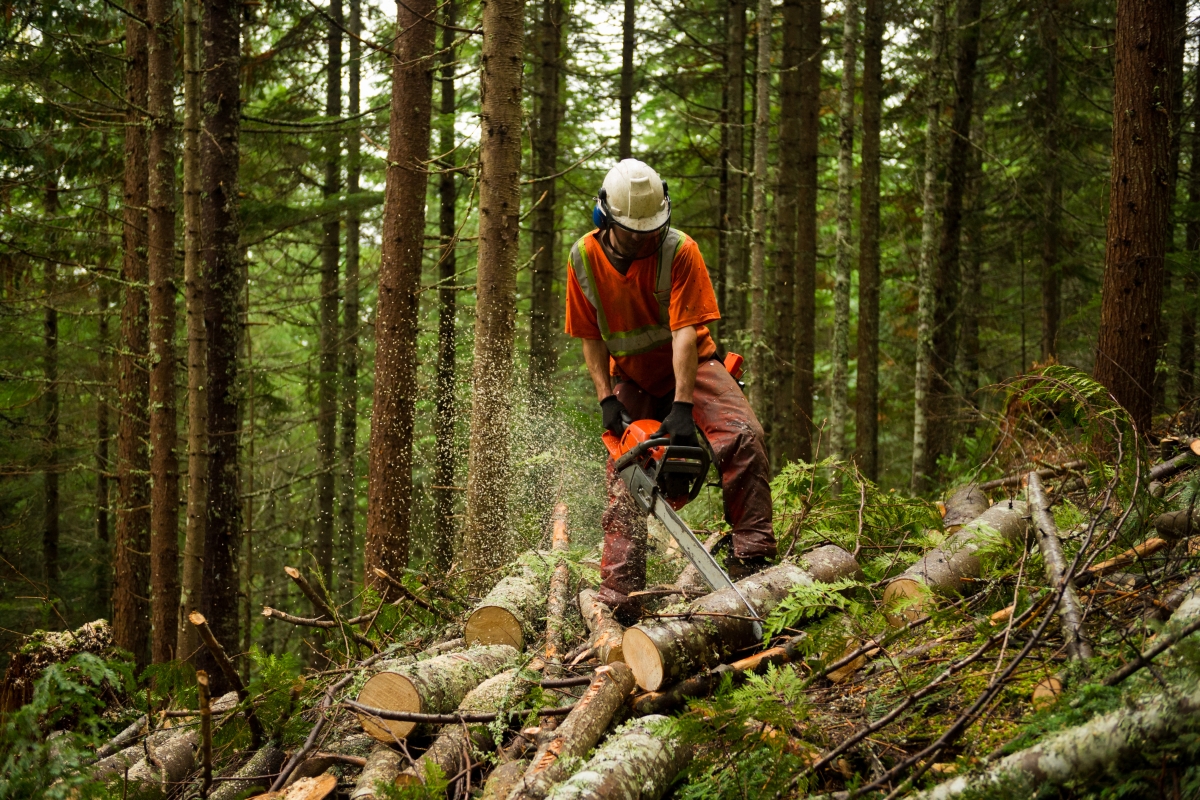Career Overview
Logging and forestry labourers assist other workers at logging sites. They plant trees, clear brush, spray chemicals and help with a range of other tasks.
Job Titles
Duties
In general, logging and forestry labourers:
- Plant and prune trees using hand tools
- Space young trees
- Attach chokers or cables to move felled trees
- Spray herbicides from the ground using hand-held equipment
- Clear trails using chain saws
- Clean up sorting areas at logging sites
They may also help with more complex tasks, such as:
- Measuring the amount of timber in a harvest area
- Assessing the harvest area and laying out roads
- Taking down dangerous trees
- Fighting fires
- Assessing waste
- Surveying the impact of root rot and insects
- Assessing streams and wetlands
Earnings
Earnings is income that workers receive in exchange for their labour. Depending on the type of employment, earnings can be in the form of wages (hourly), salaries (fixed monthly or annual) or self-employed earnings.
Work Environment
# Workers Employed
1,350% Employed Full Time
24%Logging and forestry labourers work for logging companies and contractors.
They work outdoors in a challenging environment. They are subject to all kinds of weather and to the noise of loud machinery. They work on unstable ground and steep slopes. They also face the danger of trees falling or cables snapping. They must follow strict safety rules to reduce the risks.
Some logging and forestry labourers work with drones and geographic information system (GIS) mapping.
Career Pathways
With experience, logging and forestry labourers can move into more advanced positions. These include silviculture and forestry worker, environmental monitor, chain saw and skidder operator, log truck driver, fibre hauler and logging machinery operator. Workers with specialized training can do danger tree assessments and falling.
Some logging and forestry labourers advance by apprenticing as a mechanic or in another related trade.
Occupational Interests
It’s important to understand what kinds of occupations align with your interests.
For more about occupational interests visit Skills for the Future Workforce > Characteristics.
Here are the top occupational interest(s) for this career profile:
Education, Training and Skills
Logging and forestry labourers receive several weeks of formal and on-the-job training.
Some jobs also require:
- High school diploma
- Driver’s licence
- Safety courses
- Workplace Hazardous Materials Information System (WHMIS) certification
- Chemicals application licensing
- First aid training
- Chain saw safety and faller’s certification
- Waste and residue survey certification
- Resource Inventory Standards Course (RISC) in archaeology
Education programs in B.C.

Top Skills
Every job calls for a certain set of skills. Knowing those skills is the first step in finding a good career fit.
Here, you will find the 10 most relevant workplace skills. Some are more important to achieving success in a certain career than others. These skills may come naturally to you or you may need to gain them through education, training and experience.
See the list of work-related skills below, ranked in order of importance for this career. Check out the list and see if this career matches your skills—take that first step!
Labour Market Statistics
Discover data, facts and information that have been gathered and analyzed. Learn about the characteristics of the economy and labour market in B.C.
Employment
Find out about employment types and trends by region and industry.
Employment
1,350Employment by Region







| Region | Employment | % Employment of this Occupation |
|---|---|---|
| Cariboo | 170 | 12.6% |
| Kootenay | 210 | 15.6% |
| Mainland/Southwest | 275 | 20.4% |
| North Coast and Nechako | 100 | 7.4% |
| Northeast | 15 | 1.1% |
| Thompson-Okanagan | 215 | 15.9% |
| Vancouver Island/Coast | 375 | 27.8% |
Labour Market Outlook
The B.C. Labour Market Outlook is a 10-year forecast of the expected supply and demand for labour in the province. It’s usually updated every year. The purpose is to provide British Columbians with the knowledge to make informed decisions on careers, skills training, education and hiring.
Forecasted Job Openings (2025-2035)
150Forecasted Job Openings
Forecasted Employment Growth Rate
Composition of Job Openings
Job Openings by Region (2025-2035)







| Region | Job Openings | Avg. Annual Employment Growth |
|---|---|---|
| Cariboo | 20 | 0.1% |
| Kootenay | 10 | -0.1% |
| Mainland/Southwest | 0 | -0.1% |
| North Coast and Nechako | 30 | 1.3% |
| Northeast | Not available | Not available |
| Thompson-Okanagan | 10 | 0.0% |
| Vancouver Island/Coast | 80 | 0.7% |
Industry Highlights
Learn about the opportunities in B.C.'s major industries, including employment trends, earning potential, locations of work and more.
Forecasted Job Openings by Industry
| Industry | Job Openings (2025-2035) |
|---|---|
| Forestry, Logging and Support Activities | 140 |
| Manufacturing | 10 |
Insights from Industry
Logging and forestry labourers do a variety of tasks and often move between similar jobs in the field. Experts in the field are discovering some challenges in finding trees that are available to cut.
Resources
-
B.C. Ministry of Forests, Lands, Natural Resource Operations and Rural Developmentwww.gov.bc.ca/forests
-
Council of Forest Industries (COFI)www.cofi.org
-
British Columbia Forest Safety Council (BCFSC)www.bcforestsafe.org
-
Interior Logging Association (ILA)www.interiorlogging.org/
-
SkilledTradesBCskilledtradesbc.ca/
-
Truck Loggers Association (TLA)www.tla.ca
-
Western Forestry Contractors' Associationwfca.ca







